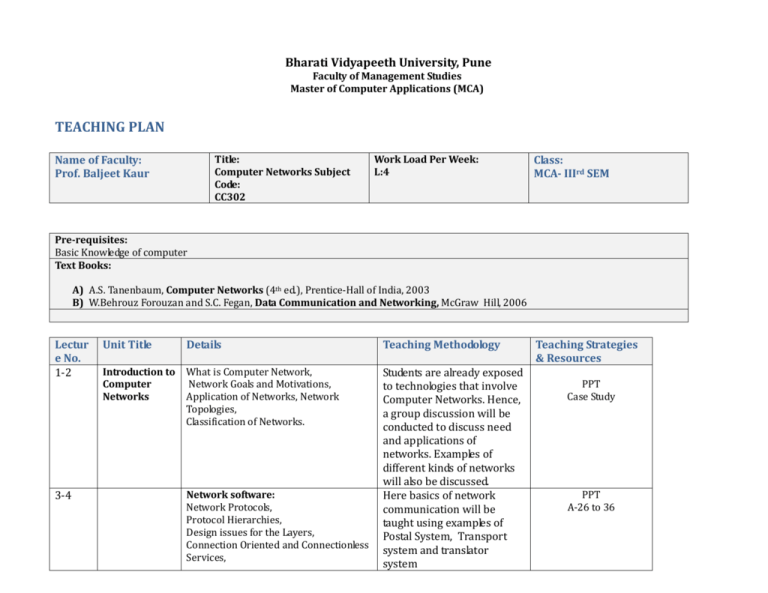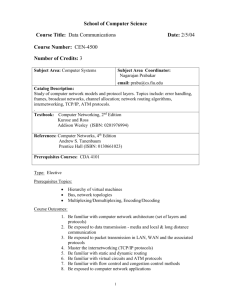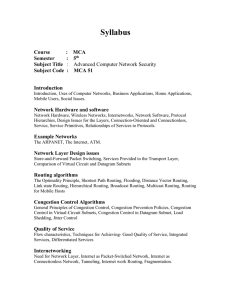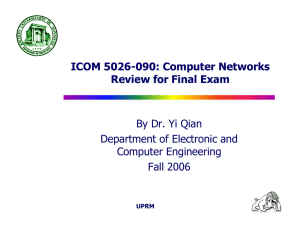TeachingPlan-Computer Network MCA
advertisement

Bharati Vidyapeeth University, Pune Faculty of Management Studies Master of Computer Applications (MCA) TEACHING PLAN Title: Computer Networks Subject Code: CC302 Name of Faculty: Prof. Baljeet Kaur Work Load Per Week: L:4 Class: MCA- IIIrd SEM Pre-requisites: Basic Knowledge of computer Text Books: A) A.S. Tanenbaum, Computer Networks (4th ed.), Prentice-Hall of India, 2003 B) W.Behrouz Forouzan and S.C. Fegan, Data Communication and Networking, McGraw Hill, 2006 Lectur e No. 1-2 3-4 Unit Title Details Teaching Methodology Introduction to Computer Networks What is Computer Network, Network Goals and Motivations, Application of Networks, Network Topologies, Classification of Networks. Students are already exposed to technologies that involve Computer Networks. Hence, a group discussion will be conducted to discuss need and applications of networks. Examples of different kinds of networks will also be discussed. Here basics of network communication will be taught using examples of Postal System, Transport system and translator system Network software: Network Protocols, Protocol Hierarchies, Design issues for the Layers, Connection Oriented and Connectionless Services, Teaching Strategies & Resources PPT Case Study PPT A-26 to 36 Service Primitives, Relation of services to Protocols, 5-6 Network Models: The OSI Reference Model, The TCP/IP Reference Model, Comparison of OSI and TCP/IP Reference Model, 7 A critique of OSI Model, A critique of TCP/IP Model. 8 Different network models and their application will be discussed along with a brief history ,their needs, advantages , comparison of different models PPT A-37 to 48 Case Study Case Study Handout Evaluation Test: 9-10 11-12 Examples of some networks: Internet, X.25, ISDN, Frame relay, ATM, Ethernet, Wireless Lans- (wi-fi) Data Transmission (Physical Layer) Signals: Analog and Digital Signals, Data Rate, Transmission Impairment, Signal Measurement : Throughput, Propagation Speed and Time, Wavelength, Frequency, Bandwidth, Spectrum 13-14 Transmission Media& its Characteristics: Guided and Unguided Media 15-16 Synchronous and Asynchronous Transmission, Multiplexing: FDM,WDM,TDM, A-49 to 68 These are the basic terminologies used in computer networks. These terminologies will be explained with the help of numerical examples. Different types and modes of communication are discussed along with media used for communication with reference to Telephone, Mobile and Computer Network. B B B 17 Switching: Circuit ,Message and Packet Switching A 18-19 Mobile Telephone Systems: 1G-AMPS,2G-GSM ,GPRS ,EDGE ,CDMA, 3G-UMTS, WCDMA, CDMA-2000 Case Study 20 21-23 Evaluation Test: Network Layer Network Layer Design Issues: Store and Forward Packet Switching, Services to Transport Layer, Implementation of Connection Oriented and Connectionless Services, Comparison of Virtual Circuit and Datagram Subnet Quiz 24-27 Routing Algorithms: Static/ Dynamic , Direct/ Indirect, Shortest Path Routing, Flooding, Distance Vector Routing , Link State Routing, Hierarchical Routing, Broadcast Routing, Multicast Routing Group activity Handout 28-30 Congestion Control Algorithms: General Principal of Congestion Control, congestion prevention polices, Load shedding, Jitter Control Group activity Handout 31-33 IP Addressing IP-Protocol, IP-Address Classes(A,B,C,D,E), Broadcast address , Multicast address, Network Mask, Subnetting, Internet control ProtocolICMP, IGMP, Mobile-IP, IPv6 Numerical Problems including subnetting 34-36 Transport and Application Support Protocols Transport and Application Support Protocols, Transport service, Service Primitives, Internet, and Transport Protocols: TCP/UDP, Remote Procedure Calls, RTP, Create a small application 37-39 Session Layer: Token Concept Demonstration through Presentation Layer: Data Encryption and Internet communication Data Security, Message Authentication, process Application Layer: Domain Name Service, Telnet, FTP, SMTP, SNMP, MIME, POP, IMAP, WWW,HTTP A-343 to 349 A-431 to 472 + Handout A-481 to 572 Handout 40 41-44 Evaluation : Assignment/ Presentation Advance Networks Advance Networks: Concept of 4G new networks in use, will be Networks, Introduction of 802.16, taught through group 802.20, Bluetooth, Infrared, MANET, discussion Sensor Networks. Technical Issues of Advanced Networks, Case Study Handout 45-47 Mobile Ad-hoc Networks: Introductory concepts, Destination-Sequenced Distance Vector protocol, Ad Hoc OnDemand Distance Vector protocol, Handout 48-49 Wireless Sensor Networks: Sensor networks overview: Introduction, applications, design issues, requirements. Handout 50 Evaluation Test: Continuous Evaluation: Sr.No. 1 2 3 4 5 Evaluation Method Test 1 Test 2 Assignment / Presentation Final Internal Attendance / Class Participation WHEN July End August End September End October End TOTAL Weightage 20 20 20 20 20 100








